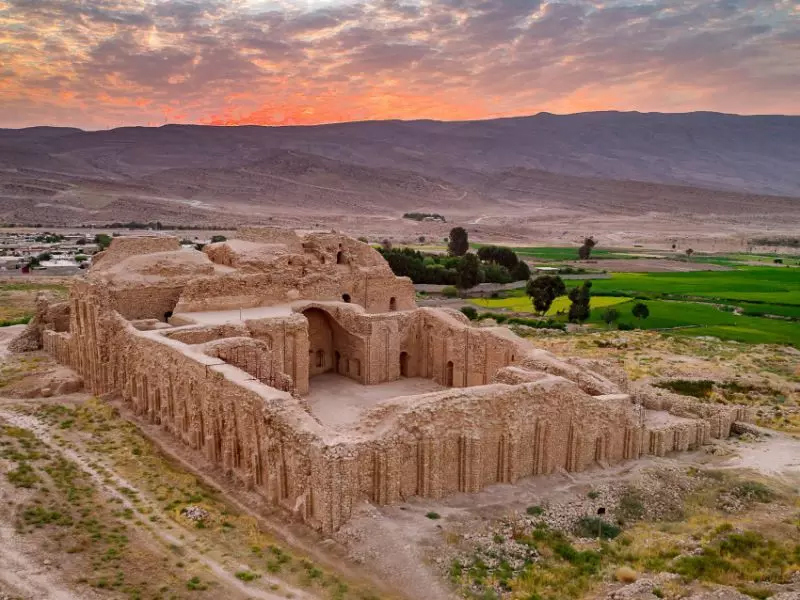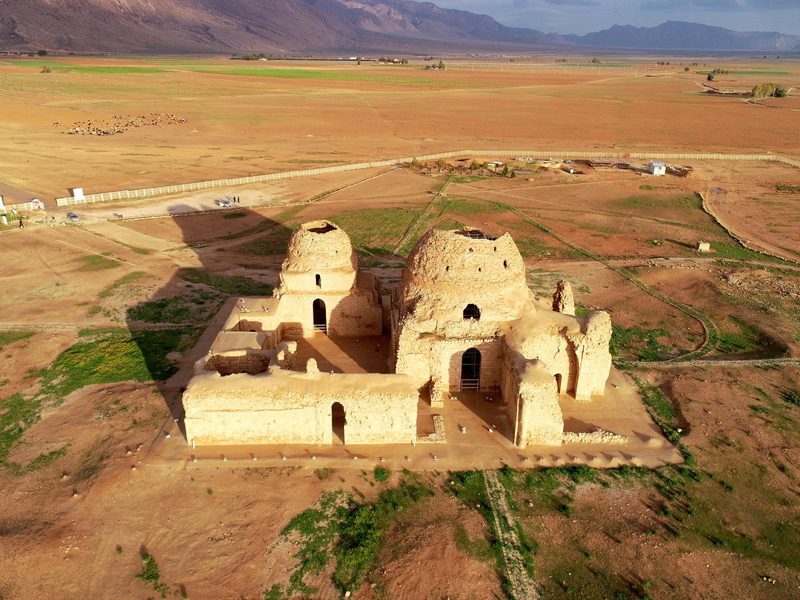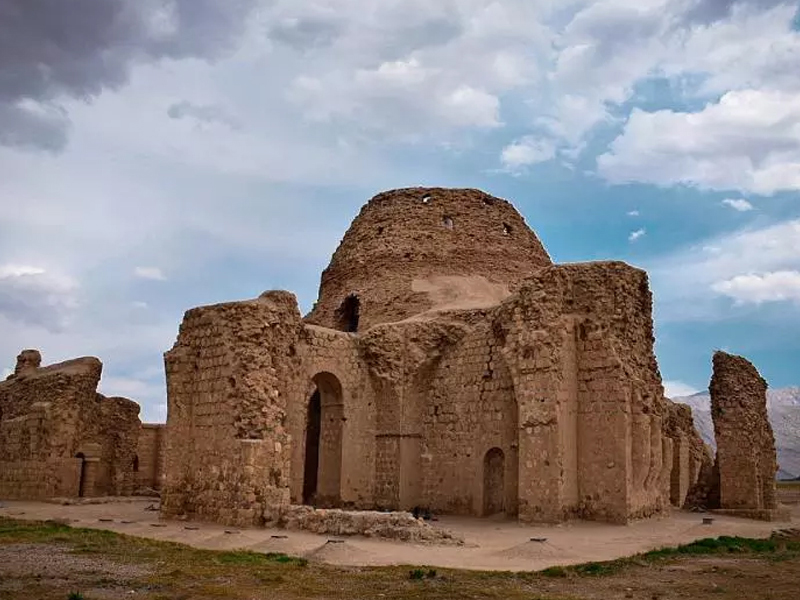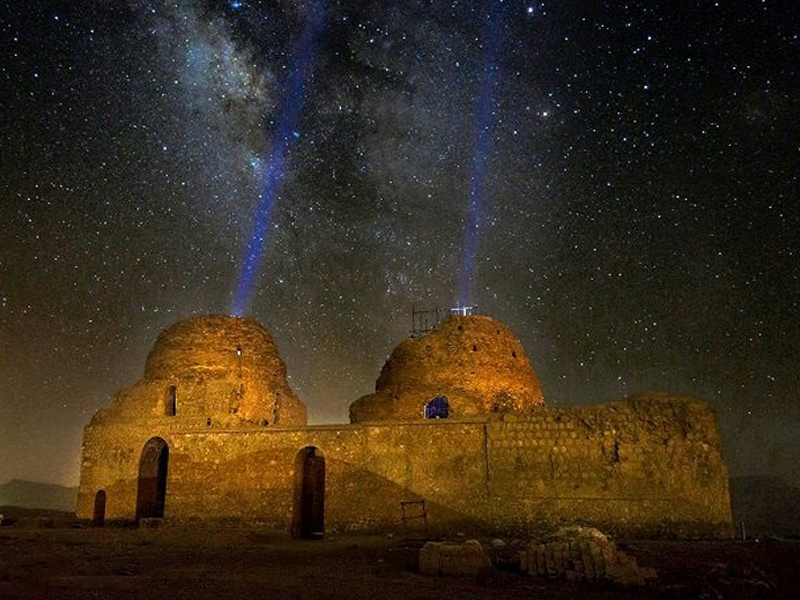The Sasanian Palace of Sarvestan is one of the most unique and well-known sites in Fars Province, Iran. It was registered as a national heritage site in the Iranian National Heritage List on September 24, 1931. This historical attraction was also inscribed on the UNESCO World Heritage List as a valuable part of the “Sasanian Archaeological Landscape of Fars” in July 2018. The four-iwan structure of this palace, known as “Chahartaq” or “Sasan Palace,” serves as a strong link between ancient Iranian architecture and the Islamic era.
Book Iran Air flights from London to Tehran and Tehran to London with Eligasht UK:
Sarvestan Fire Temple in Fars and a Passage to Ancient Iran
Address: Sarvestan, Fars Province, 14 kilometers south of Sarvestan, on the Shiraz-Fasa road.
According to the majority of domestic and foreign researchers, the Sarvestan Fire Temple belongs to the Sasanian dynasty and specifically to the reign of King Bahram V in the 5th century AD. Precise dating of the structure indicates that it entirely belongs to the Sasanian period, and it has also received attention during the Islamic era. However, there are multiple opinions regarding the function of this structure. Some consider it a fire temple, while others suggest that it might have been a royal hunting lodge.
Access to the Sasanian Palace in Fars Province
To reach the Sasanian Palace of Sarvestan, you need to travel from Shiraz to Fasa. Then, in the southern part of Sarvestan, on the Sasanian route, the palace will appear before you. It is a beautiful complex in Fars Province, approximately a two-hour drive from Shiraz at an average speed.
Exact Access Route to Sarvestan Palace
After entering Fars Province and the city of Shiraz, you should travel towards Sarvestan by car or bus. Five kilometers after the Fasa road, you will see a large sign indicating the end of the road to the palace. From this sign, it will be a 5-kilometer journey to reach Sarvestan Palace.
Additionally, if you intend to travel to Sarvestan and visit this palace from the south, you should take the Shiraz-Bandar Abbas road, also known as the Shiraz-Sarvestan freeway. Proceed towards Bandar Abbas on this route, and after that, continue towards the Khavaran-Sarvestan road. After passing the Shahid Beheshti Camp in Sarvestan and before reaching the Nazarabad area, you will see a road that you should enter. This road will lead you to Sarvestan Palace.
Sarvestan Palace Tour for Ancient Iran Enthusiasts
At the beginning of this article, we mentioned that Sarvestan Palace is one of the country’s historical and famous buildings belonging to the Sassanian dynasty, located in Fars Province, Iran. It is a valuable historical mansion with a history of more than a thousand years and has been nationally registered. This mansion covers an area of 25 hectares and has survived the reign of Bahram Gur, one of the Sassanian kings. It has a striking resemblance to the Ardeshir Babakan Palace in Firuzabad, and locals also know it as the Sassan Palace and Chahartaqi.

The Sasanian Empire
The Sasanian Empire, also known as the Neo-Persian Empire, was one of the most powerful and influential empires in ancient history. It spanned from the 3rd century AD to the 7th century AD and was known for its military prowess, administrative efficiency, and cultural achievements. The Sasanians were avid patrons of art and architecture, and their palaces and buildings were a reflection of their wealth and sophistication.
Historical Background of Sarvestan Palace
Based on the obtained documents and conducted research, various opinions have been presented regarding the construction date of this building. “Sir Gore Ouzly,” a merchant, linguist, diplomat, and the first official ambassador of Britain to Iran, was the first person to conduct extensive studies and research on Sarvestan Palace. In 1810 AD, after visiting the palace, he introduced it as a brick structure with an Islamic style and introduced it to the world.
In 1840 AD, Eugene Flandin, a French politician, painter, and architect, after visiting this palace, provided various and interesting opinions about it. He believed that Sarvestan Palace was initially built as a palace and compared it to several different quadrangular structures. He concluded that the Sarvestan building is a fire temple that has survived from the Sassanian period.
Madame Jean Dieu Lafont, a renowned French civil engineer, architect, and archaeologist, also conducted further research and introduced this palace as belonging to the late period of the Achaemenid rule and empire. Finally, in 1910 AD, Emil Herzfeld, a German Iranologist and prominent archaeologist, attributed the age of this palace to the reign of Bahram V, also known as Bahram Gur, who was the son of Yazdgerd I, a Sassanian king. Bahram Gur held the Sasanian dynasty from 421 to 438 AD. He attributed this mansion to Bahram V, who ordered its construction. It was then built by Mehr Narseh, the cunning minister of Bahram Gur or Bahram V.
The Beginning of Life: Sasanian Palace of Sarvestan
After that, in the year 1980 AD, extensive research and studies were conducted by the University of New York on the Sasanian Palace of Sarvestan. Based on these studies, the Sasanian Palace of Sarvestan in Fars Province was compared architecturally to its contemporary palaces such as the Umayyad palaces in Jordan, and it was concluded that this structure belongs to the Al-Booyeh period.
These discussions continued until the 2000s when archaeological excavations carried out in the vicinity of this palace revealed that it was built during the late Sasanian period and at the beginning of the Islamic era, and it was also used during the Islamic period. Furthermore, extensive repairs and reconstructions have been carried out on it. Then, in 2018, it was nominated for inclusion in the World Heritage List, and UNESCO experts reviewed its file.
After these reviews, it was announced that this structure belongs to the Islamic period and will not be included in the Firuzabad and Bishapur files. Then, the carbon-14 dating project was initiated, during which numerous pieces of wood were found in the walls and small pieces of charcoal were discovered in the mortar of the walls and domes using radiocarbon dating. Based on this evidence, the structure was attributed to the Sasanian period, which was also used during the Islamic era.

Architecture of the Sasanian Palace of Sarvestan
The Sasanian Palace of Sarvestan exhibits several architectural features that are characteristic of the Sasanian period. The most prominent feature is the use of the iwan, a vaulted hall with a large arched opening on one side. The Sasanian Palace of Sarvestan was built using various materials such as plaster, brick, and stone. The main facade of the palace, located on the southern side, consists of a central courtyard and two other courtyards on the sides. A square-shaped central courtyard with a length of 13 meters, width of 13 meters, and height of 18 meters is located in the central part of the palace, connecting to the main hall and courtyard. The northern part of the structure also leads to the outer courtyard through several steps, while the southern part has access to another side courtyard.
The large eastern courtyard has direct access to the central hall and other sections. On both sides of the structure, two very narrow rooms with vaulted ceilings are placed asymmetrically and not facing each other. Additionally, to strengthen and support the domes, elephant ears and earrings have been used. These columns are responsible for protecting and supporting the palace’s roof. Irregularities and mounds are also visible in the surrounding areas of this palace, indicating the possible existence of other structures nearby.
Similarities between the Palace of Ardeshir-e Babakan and the Sasanian Palace of Sarvestan
“André Godard,” a French architect and tourist, considers the Sasanian Palace of Sarvestan to be very similar to the beautiful Palace of Ardeshir-e Babakan and believes that this palace has been better preserved and maintained.
Furthermore, more skill has been employed in constructing the domes and vaults. The back part of the hall, where the main dome is located, is built similarly to the Palace of Ardeshir-e Babakan, with surrounding buildings for residential purposes. However, no symmetry is observed, and the dimensions of the rooms are not uniform.
The Sasanian Palace of Sarvestan, like the Palace of Ardeshir-e Babakan, has more diverse and freer details. Its size is one-fourth of the size of the Palace of Ardeshir-e Babakan, and apparently, it was used for receptions. However, André Godard believes that this palace was even too small for receptions. Furthermore, the other halls are spacious and magnificent, but their number is small, and their doors open towards the outside. It is unlikely that these halls and rooms served as living quarters.
The square hall and courtyard also have small interconnected doors and are unified. Another interesting point is that the Sasanian Palace of Sarvestan, just like the Palace of Ardeshir-e Babakan, has dome-shaped vaults made of brick.

The Function of Sarvestan Palace
There are many disagreements regarding the Sasanian Palace of Sarvestan. Some researchers and archaeologists believe that the space of this palace was smaller than a royal palace and that it was originally a fire temple. It served as a central fire temple where Sasanian religious rituals and customs were performed. On the other hand, some others believe that Sarvestan Palace had a larger and more expansive environment and was primarily a hunting lodge and retreat for the king.
Other historical and geographical sources have also provided various information about this palace. For example, in his book “Al-Masalik wa Al-Mamalik,” Ibn Khordadbeh, after providing extensive descriptions of the beautiful and historic city of Estakhr, introduces it as one of the oldest cities in the Pars region and considers Sarvestan Palace as one of its fortresses. He also mentions a very large and spacious structure made of plaster and stone, consisting of columned halls, domes, rooms, multiple courtyards, and various corridors. Finally, he attributes the construction of the palace to Bahram V, a Sasanian king.
related post
10 of the most spectacular attractions of Shiraz city in Iran
don’t forget to visit Bagh-e Nazar and the Pars Museum in Shiraz!
Visiting the Sasanian Palace of Sarvestan
Finally, it is recommended to choose the spring and early autumn seasons for visiting the Sasanian Palace of Sarvestan. During these two seasons, the weather is pleasant, and you can have an unforgettable visit to this historic monument without enduring exhausting heat. The visit to the palace is completely free, but unfortunately, there are no amenities, buffets, or other facilities available nearby. It is advisable to bring food and drinking water with you.
Additionally, if you happen to visit the palace in the darkness of the night, we recommend not to miss the opportunity to admire the starry and beautiful night sky in this area. It is worth noting that the palace is located away from residential areas and has suitable lighting, making it an excellent place for night photography. Lastly, it is important to remember not to cause any damage to the historical artifacts and to leave minimal traces during your visit to these sites.
FAQ
- What is Sarvestan Palace?
Sarvestan Palace is an ancient Sassanian palace located in Sarvestan, Fars Province, Iran. It is a significant historical site that showcases the architectural and cultural achievements of the Sassanian Empire.
- When was Sarvestan Palace built?
Sarvestan Palace was constructed during the reign of Bahram V, a Sassanian king, in the 5th century CE. It is believed to have been completed around 420 CE.
- What are the notable features of Sarvestan Palace?
Sarvestan Palace is known for its unique architectural style, characterized by its domed chambers and intricate stone carvings. The palace consists of a central iwan (vaulted hall) surrounded by smaller rooms and courtyards. It is an excellent example of Sassanian palace architecture.
- Is Sarvestan Palace open to the public?
Yes, Sarvestan Palace is open to the public. Visitors can explore the palace complex, admire the architectural details, and learn about the rich history of the Sassanian Empire.
- Are there any nearby attractions or sites of interest near Sarvestan Palace?
Yes, in addition to Sarvestan Palace, the region offers other notable attractions. Nearby, you can visit the ancient city of Estakhr, which was once a significant center in the Sassanian Empire. Additionally, the city of Shiraz, known for its rich cultural heritage and famous landmarks like Persepolis, is located within a reasonable distance from Sarvestan Palace.

